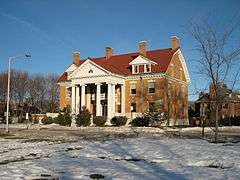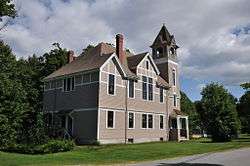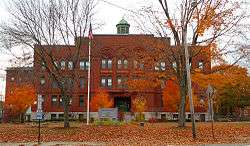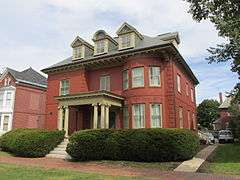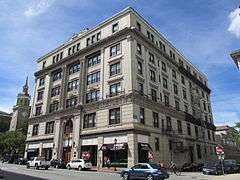Frederick A. Tompson
Frederick Augustus Tompson (1857-1919), often misspelled Thompson, was an American architect from Portland, Maine.
Tompson was born in Portland in 1857. In 1876 he entered the office of Francis H. Fassett, Maine's most prominent architect at the time. He worked his was up through the office until 1886, when he was promoted to partner in the new office of Fassett & Tompson. That association lasted until the end of 1890, and Tompson opened his own office in January 1891.[1] He remained in private practice until his death on February 2, 1919.[2]
Tompson's practice was succeeded by Charles O. Poor, Tompson's chief assistant.[3] Later that year Poor formed a partnership with John P. Thomas. Poor died in 1922, and Thomas opened an office under his own name in 1923.[4] He became one of Maine's most successful architects.
He was the designer of several of Portland's most prominent turn-of-the-century structures, and his West house of 1911 remains the city's largest private residence.[5] Several of Tompson's works have been placed on the National Register of Historic Places, and several others are contributing properties of listed historic districts.
Works
- Rich Building, 106 Exchange St., Portland, Maine (1892)[6]
- Walker Memorial Hall, Highland Rd., Bridgton, Maine (1892)
- Castle-in-the-Park, Deering Oaks, Portland, Maine (1894)[7]
- Walker Memorial Library, 800 Main St., Westbrook, Maine (1894)
- Portland Armory, 20 Milk St., Portland, Maine (1895)[6]
- John W. D. Carter House, 384 Spring St., Portland, Maine (1897)[8]
- Emerson School, 13 Emerson St., Portland, Maine (1897)[7]
- Charles O. Haskell House, 52 Neal St., Portland, Maine (1897)[8]
- Y. M. C. A. Building, 7 Congress Sq., Portland, Maine (1897) - Demolished.[9]
- Henry P. Cox House, 231 Western Promenade, Portland, Maine (1898)[8]
- Deering High School (Old), 552 Stevens Ave., Deering, Maine (1898)[10]
- Howard C. Smith House, 23 Bramhall St., Portland, Maine (1900)[8]
- Union Mutual Life Insurance Building, 120 Exchange St., Portland, Maine (1900)[11]
- Frederick A. Tompson House, 33 Carroll St., Portland, Maine (1901)[8]
- Walker Manual Training School, 45 Casco St., Portland, Maine (1901)[7]
- Everett Chambers, 51 Oak St., Portland, Maine (1902)
- Adam P. Leighton House, 261 Western Promenade, Portland, Maine (1902-03)
- State Street Entrance, Deering Oaks, Portland, Maine (1902-04)[7]
- Samuel Wilde Memorial Chapel, Evergreen Cemetery, Portland, Maine (1902)
- Colonial Hotel, 179-185 High St., Portland, Maine (1904) - Demolished.[12]
- Portland Children's Hospital, 68 High St., Portland, Maine (1908)[13]
- Trelawny Building, 655 Congress St., Portland, Maine (1909)[7]
- Masonic Temple, 415 Congress St., Portland, Maine (1911)
- George C. West House, 181 Western Promenade, Portland, Maine (1911)[8]
- Portland Exposition Building, 239 Park Ave., Portland, Maine (1914)[7]
- Joseph W. Whitney House, 22 Clifford St., Portland, Maine (1916)[8]
Gallery
References
- ↑ "Fred'k A. Tompson". Board of Trade Journal Jan. 1904: 356.
- ↑ American Contractor 15 Feb. 1919: 38.
- ↑ American Contractor 22 March 1919: 39.
- ↑ American Architect 1923: 306.
- ↑ Murphy, Kevin and Kim Brian Lovejoy. Colonial Revival Maine. 2004.
- 1 2 "Portland Waterfront NRHP Nomination". 1974.
- 1 2 3 4 5 6 Bibber, Joyce K. and Earle G. Shettleworth, Jr. Postcard History Series: Portland. 2007.
- 1 2 3 4 5 6 7 "Western Promenade Historic District NRHP Nomination". 1984.
- ↑ American Architect and Building News 27 Feb. 1897: xiv.
- ↑ School Journal 1 Jan. 1898: 31.
- ↑ American Architect and Building News 17 March 1900: xii.
- ↑ Board of Trade Journal March 1904: 423.
- ↑ Engineering Record 3 July 1909: 70.
